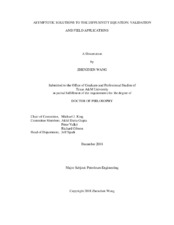| dc.description.abstract | Unconventional resources have come to play an increasingly important role in both the US and world energy supply. The success of their development is due to the wide application of hydraulic fracturing techniques, which create complex fracture geometries with large effective areas. A reliable characterization of the fracture/horizontal well system and resulting reservoir depletion becomes a challenging task for both analytic and numerical approaches. In this dissertation, we tried to combine a novel coordinate system together with a series of semi-analytic approximations, to reveal the direct relationship between production data and the transient drainage volume, and predict recovery.
We first studied how a pressure front propagates in an infinite domain under fixed rate production, which is crucial to welltest analysis and drainage volume calculation. To avoid the expenses of numerical simulation, we developed an alternative approach by directly solving the propagation equation for the pressure “front” which can be derived using asymptotic ray theory. It draws upon an analogy between a propagating pressure front and a propagating wave front, making it applicable to pressure transient analysis.
Next, we showed the development and validation of new asymptotic approximations to handle both variable rate drawdown and boundary effects. We extended the utility of the semi-analytic solutions to more realistic cases, including large changes in reservoir properties, pressure transient analysis with wellbore storage, and rate transient analysis in bounded reservoirs. This technique enables us to describe pressure propagation from fractured wells into the surrounding formations and a better drainage volume characterization, which is useful for both well spacing calculation and multi-stage fracture spacing optimization.
Finally, we proposed a data-driven model-free approach for production data analysis. It provides a simple and intuitive understanding of the transient drainage volume and instantaneous recovery efficiency, irrespective of the complexity of the reservoir depletion geometry. The novel drainage volume diagnostic plot yields better physical resolution and which can identify more detailed characteristics of the underlying flow geometry. The results of the analysis have been used for the characterization of hydraulic fracture and reservoir properties, including the prediction of fracture surface area, matrix permeability, and estimated ultimate recovery. | en |


